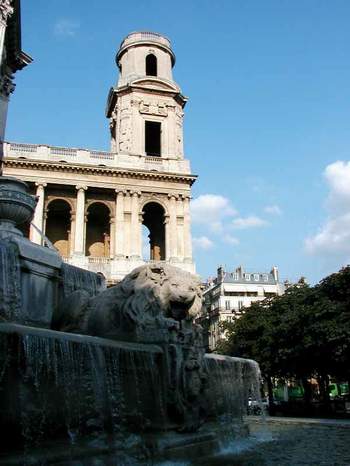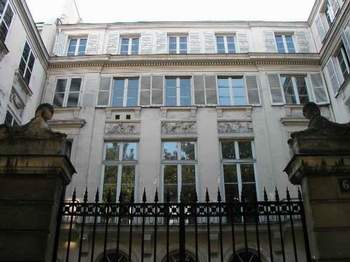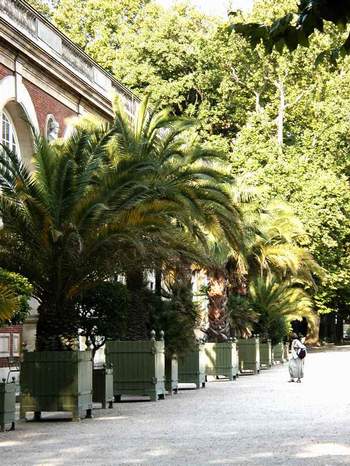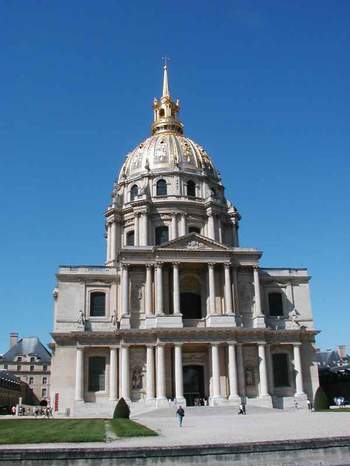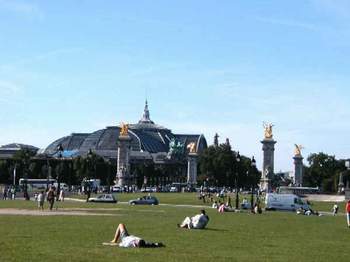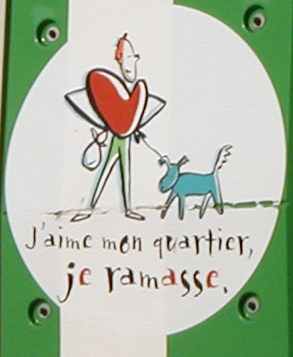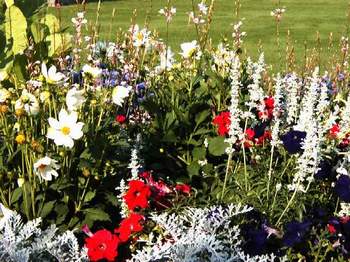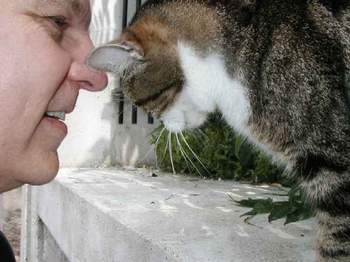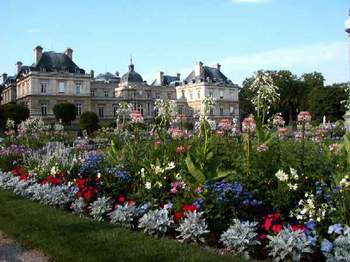 Senate building, at the north end of the Luxembourg Gardens.
Fountain with lions in front of St. Sulpice.
One of Hemingway's apartments when he lived in Paris. He and his wife at the time lived in the apartment on the main floor, with the tall windows. This is on rue Férou, between the Luxembourg Gardens and St. Sulpice. Hemingway had a way of offending people eventually, and he must have offended the French because there is no plaque on this historic site.
Palm trees in the Luxembourg gardens -- a testimony to the Gulf Stream and its effect on the weather in this part of Europe.
Lots of people enjoy the Luxembourg gardens on a Sunday evening. This is exactly what the Revolutionaries had in mind, I think.Friday, July 25When Tom finished working yesterday, we walked over to the Musée Rodin, which is much closer than we originally thought. There we paid just for entrance to the garden because we've seen the museum before, and because it was such a perfectly lovely day that we did not want to be inside. On the way over there, we saw something we've never seen on the streets of Paris before: a stripped car.
Invalides was glistening in the sun.
On the other side of Invalides (below), lots of people were using the grand park there. The gold figures you see on stanchions are on my favorite bridge, Alexandre III. The large glass building beyond that is the Grand Palais, used for special exhibitions only.
July 28When Tom finished working yesterday we went to the part of the 19th arrondissement where it joins with the 20th arrondissement. In prior years, we have not been terribly impressed with these two arrondissements, but I was encouraged by what I read in two of our guidebooks -- this particular area, Belleville, supposedly had retained some of its old village charm. The only good thing I can say about Belleville is that it is on a hill, and on a day like yesterday, with lots of air pollution, you can go there and be above the worst of it. The thing that bothered me the most about Belleville is how dirty the streets are. I don't know if it is because they don't wash the streets and sidewalks every morning (as they do in the 15th and probably every other arrondissement) or if it is because its people just make them so dirty & littered every day. I think it must be the former. Belleville has some terrific views (if the air is clear) but some of the spots mentioned in the guidebooks no longer have views because weed trees (ailanthus -sp?) have been allowed to grow to the point where they totally obscure the view. I even saw an alanthus tree growing out of a windowbox in Belleville -- such is the level of neglect! When we came down from the steps of one of the places where there should have been a view, we rounded the corner and heard a cat calling to us. There she was; she popped right out of the bushes at face level (because of a retaining wall). She talked and talked, and she pressed her face against my face several times. We attempted to catch her on the camera, which was difficult because she moved around a lot. Here she is -- Miss Belleville:
The 19th and 20th, we note from our various visits there over the past few years, have lots of ugly modern architecture. This is because the area was so incredibly blighted in the 19th century (a slaughterhouse was there, as well as an extensive seedy section with lots of people of ill repute) that there simply wasn't much good architecture to preserve. The need for housing in the past century got the better of the architects and planners, and they put in some very ugly, high-density, unimaginative structures. For centuries, the area has been home to immigrants of all origins. The ethnic variety is astounding to this day. But I think this is an area people leave as soon as they can. We did see enough in the way of construction work (i.e., "investment") going on that we think perhaps this is the next area ripe for "gentrification" in Paris. The entire day was unremarkable -- we returned home, and because we'd had lunch at an okay Italian restaurant in Belleville, we weren't particularly hungry so we just did a little shopping in the neighborhood and had bread, cheese and fruit on the balcony for a light dinner. We love these informal evenings on the balcony, where we can watch the life of the neighborhood down in the streets, the life of the chimney swifts circling the buildings, and the evening sky, with the sun glowing red from the air pollution. The days are getting a little shorter now. I read on the balcony only until 9:30, instead of 10:30. The book I'm reading about the Rothschilds is providing me with lots of good background and interesting anecdotes about Paris. For example, next to a very pretty hillside park that we saw in Belleville (Parc Maison de L'Air) is the "A. de Rothschild Eye Bank." I guessed that "A." stood for Alphonse and checked the book's index. Sure enough, Alphonse had been out hunting with friends and an inexperienced member of his shooting party fired a shotgun too close to his face. He lost an eye. He never revealed the identity of the individual who misfired the gun, and he bore his injury stoically. It was in his will, I think, that he eventually provided for this ophthalmologic institute to be established -- just one of a great, huge number of charities established by the Rothschild families. |
July 28When we arrived back in Paris at the Gare du Nord on Sunday evening, we immediately boarded the Métro, line 4, on our way home to the apartment. It was very crowded. I was surprised about that, because this was at almost 8pm. But we squeezed into the back of a subway car, and Tom had control of our suitcase. Then two guys tried to squeeze in behind him. One was perfectly honest, the other was a pickpocket. Tom instinctively felt for his wallet in his back pocket. (He keeps two separate wallets now, so pickpockets can't get everything.) Sure enough, there was a hand in his back pocket, with fingers on either side of the pocket's button. Tom just grasped the bad fingers, removed them from his pocket, and shook them loose in front of their owner. The pickpocket said nothing, and he disembarked at the next stop. A couple people around us knew what had happened. The pickpocket was empty-handed, and we felt victorious. What a welcome home! On Monday, Tom worked at the computer. Then we went out at about 5:30 and took the number 10 line to Sèvres-Babylone. We discovered how pleasant the Square Boucicaut is -- when we've gone to that stop before, it was always because we were going to Bon Marché to shop, and I guess we hadn't noticed this nice little park. The weather was finally beautiful, and lots of people were using the park as a place to unwind after work. It's a short walk from there to St. Sulpice, our friend Bob E's favorite church in Paris (it was Hemingway's, too). The left steeple was engulfed in scaffolding, so the pic only shows the right one. This church has a large square in front of it, with a big fountain with lions. On some day of the week (Wednesday?), there is a market for antique dealers in front of this church. Then it was another short walk to the Luxembourg Gardens, and the pictures tell the story there. After our visit there, we walked back to St. Sulpice and then across the 7th arrondissement via the rue Babylone, the most direct route back to the 15th. Don't miss the Jardin C. Lebouré on this street -- it isn't in the guidebooks, and it is a park that is used by the well-to-do families of the 7th and their children. A very shady arbor covers one side of the park -- an excellent place to rest on a warm day. We walked down to the little neighborhood that we have selected for our imaginary future Parisian home. It is in the 15th, but a piece of the 15th that juts into the 7th, and it looks like the 7th (which is a plus). It consists of a small collection of streets, at the center of which is Square Georges Mulot -- not really a square, but a larger than average intersection with a monument in the middle. There is a restaurant there (l'Antre Amis, 9, rue Bouchut) that we'd been meaning to try, and since it was 9pm, we went in. It was entirely occupied by locals, and the food was terrific. At 10:30, we walked on home in the fading light. We went by the Hotel de L'Avre, a two-star hotel recommended to us by Dean and Alvi. This is where we may put up visitors when we feel that the apartment is just too crowded. The hotel is on a narrow street by the same name, very close to the apartment.
This sign on the side of a street cleaning truck is part of a campaign to get Parisians to clean up after their dogs. It is working, but one must still watch the pavement in Paris. Each arrondissement is divided into quarters. All city services are organized by arrondissement, by quarter. This sign says, "I love my quarter; I clean up [after my dog]." One sees signs with this same message near public parks and squares.
One of the many Wallace fountains to be found in small parks in Paris. This one is in the square in front of St. Sulpice. Wallace was an English gentleman who loved Paris. He gave the city these fountains, so her people would never be thirsty.
Flowers in the Luxembourg.
The Medici Fountain in the Luxembourg.
Musée Rodin
The thinker.Last night (Tues.), we ate at Le Tire Bouchon (the corkscrew) -- one of our favorite neighborhood restos from last year. It was better than ever -- and a terrific value. One of the owners, Isabelle, waited on our table. She knows English! We still spoke to her in French, but she gave us some lovely descriptions of dishes in an exotic lilting English. We wonder who taught her. And she spoke so quickly -- amazing.
Miss Belleville the cat astutely picked up the scent of cat people and came out of the shrubbery, calling to us, to rub faces. The macro feature on the digital camera works fairly well!
Belleville has more than its share of ugly modern architecture, but this one should win a prize for its ugliness. |
